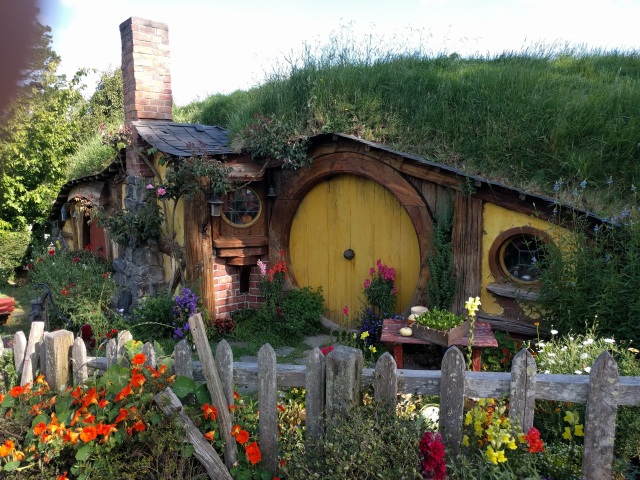
Picture courtesy of Wikimedia
Flightless birds with nostrils at the end of their beak, worms that glow in the dark to create star-spangled ceilings in caves, ostriches calmly grazing with cattle — it is amazing the creatures you can see on the North Island. And that doesn’t count hobbits!
In early December, on one of the last days that we had the entire Green family together in New Zealand, we took the day to see some “only in New Zealand” sights.
The day started with a visit to Otorohanga Kiwi House to see the kiwi – New Zealand’s national bird. As a flightless, nocturnal, endangered bird, the kiwi is difficult to spot in the wild. The kiwi is unique to New Zealand, although five species have developed, ranging from the Great Spotted Kiwi, which stands 18 inches high, to the Little Spotted Kiwi, which is less than 10 inches high. At the Kiwi House, we were able to enter a “moonlight room” and watch the ranger put out food for a female Great Spotted Kiwi. The kiwi is very territorial, and launched quite an attack on the ranger (who was prepared with large boots and rubber leggings). The kiwi is flightless, but has very strong legs and sharp claws, as well as its long beak. Not to be tackled lightly! When the ranger had finished feeding the kiwi and taken off all of her protective gear, we learned that the kiwi has is the one bird that has nostrils at the end of its beak. It has lousy eyesight, but learns about its surroundings (and finds insects and fruit to eat) by sticking its beak rapidly into the ground. When it finds a goody, it grabs it in its beak and flips it up into the air so it can fall back into the long beak and down the throat.
Our next stop was a tour of the Waitomo Glow Worm Caves. Although very touristy, this tour did give us the opportunity to see a fantastic underground cavern lit up by thousands of tiny larvae that are bioluminescent — they glow in the dark to attract insects that get caught on long, sticky filaments the larvae dangle below them. Sitting in a boat in an underground cavern with no natural light, the thousands of glowworms were like starlight — giving off enough light to be able to see your hands in front of you, and the dim silhouette of your neighbor. We look forward to seeing more of these incredible starry ceilings in February when we go on a caving trip with local Quakers.
Leaving the glowworms, we had to stop to snap a photo of several ostriches calmly grazing in a field, with cattle in the distance. (True, an ostrich is not an “only in New Zealand sight”, but it was still fun to take photos of!) Having seen the damage an 18-inch high flightless kiwi can do with its legs, it was frightening to think what this 6-foot tall flightless ostrich might do if it got upset!
 Our last stop of the day was at Hobbiton, where director Peter Jackson recreated Tolkien’s Shire for the Lord of the Rings Trilogy and again for the Hobbit movies on 12 acres of a sheep and cattle farm. We learned that since the Shire figures in the beginnings and ends of the movies, only about 30 minutes of the film (out of 25 hours) show this bucolic wonderland. (The scenes inside hobbit holes were filmed on a set elsewhere.) But that didn’t stop Jackson from creating the outsides of 28 hobbit holes — some scaled for long shots with no humans (or hobbits) in sight for scale, some scaled for hobbits to be filmed in front of, and a few for dwarves, humans, or wizards to be filmed in front of. The detail is amazing, from the hobbit-sized laundry lines, to the delicate carving of the window sills. But I (Marsha) am still not sure which is more amazing — the detail given to creating this set, or the fact that on a single day, they can have more than 2000 people touring it!
Our last stop of the day was at Hobbiton, where director Peter Jackson recreated Tolkien’s Shire for the Lord of the Rings Trilogy and again for the Hobbit movies on 12 acres of a sheep and cattle farm. We learned that since the Shire figures in the beginnings and ends of the movies, only about 30 minutes of the film (out of 25 hours) show this bucolic wonderland. (The scenes inside hobbit holes were filmed on a set elsewhere.) But that didn’t stop Jackson from creating the outsides of 28 hobbit holes — some scaled for long shots with no humans (or hobbits) in sight for scale, some scaled for hobbits to be filmed in front of, and a few for dwarves, humans, or wizards to be filmed in front of. The detail is amazing, from the hobbit-sized laundry lines, to the delicate carving of the window sills. But I (Marsha) am still not sure which is more amazing — the detail given to creating this set, or the fact that on a single day, they can have more than 2000 people touring it!


